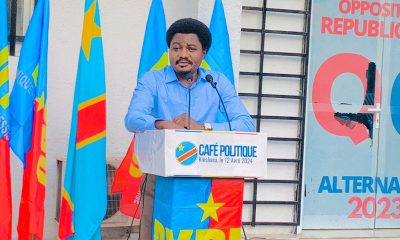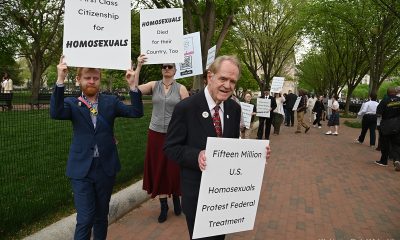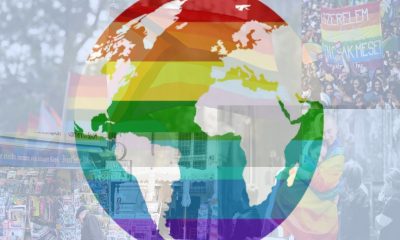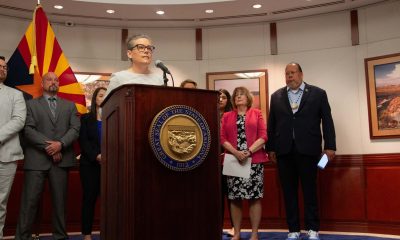News
Trans military ban ignored by reporters, White House at briefing
Blade again ignored during briefing


White House Principal Deputy Press Secretary Raj Shah took no questions on President Trump’s trans military ban. (Image courtesy C-Span)
On the first White House news briefing after President Trump reaffirmed his ban on transgender people serving in the U.S. military, White House Deputy Press Secretary Raj Shah declined to address the issue, nor did any reporters from mainstream media outlets ask about it as part of their questioning.
The main focus from reporters on Monday during the 20-minute briefing, characteristically abbreviated for the Trump White House, was instead the “60 Minutes” interview Sunday night with porn star Stormy Daniels and the details she revealed about her alleged sexual affair with Trump. Other questions were about the U.S. expulsion of 60 Russian diplomats as a result of Russia’s apparent use of a military-grade chemical weapon in the United Kingdom, which killed a former Russian spy.
The Washington Blade was seated in the third row and had a hand up during the briefing, but Shah declined to recognize the LGBT outlet for a question. At one point, Shah looked directly at the Blade, but skipped the publication for another reporter. That’s consistent with the Trump White House record of virtually ignoring the Blade during the White House briefings.
Had the Blade been called on during the briefing, the LGBT outlet would have asked about the transgender military ban, which was made public late Friday night just as the weekend started at a time when media coverage was limited and the White House wasn’t taking questions on the issue.
At the close of the briefing, another non-mainstream media standing in the aisle sought comment from Shah on the transgender military ban by shouting out an inquiry. Shah looked at the reporter as he exited the briefing, but had no response.
The Blade followed up with Shah after the briefing by submitting two questions via email to him and other staffers in the White House.
Here are the questions:
1. Did the president, Vice President or anyone at the White House seek to influence the findings in the report from Secretary Mattis made public Friday?
2. Multiple courts have ruled prohibiting transgender service is unconstitutional. Isn’t the policy a non-starter?
Trump announced he’d keep his ban on transgender service in the military following a report signed by Defense Secretary James Mattis recommending limited access to transgender people in the armed forces. The expectation is the policy will be unenforceable because six courts — four trial courts and two circuit courts — have determined barring transgender people from the U.S. military is likely unconstitutional.
Federal Government
Lambda Legal praises Biden-Harris administration’s finalized Title IX regulations
New rules to take effect Aug. 1

The Biden-Harris administration’s revised Title IX policy “protects LGBTQ+ students from discrimination and other abuse,” Lambda Legal said in a statement praising the U.S. Department of Education’s issuance of the final rule on Friday.
Slated to take effect on Aug. 1, the new regulations constitute an expansion of the 1972 Title IX civil rights law, which prohibits sex-based discrimination in education programs that receive federal funding.
Pursuant to the U.S. Supreme Court’s ruling in the landmark 2020 Bostock v. Clayton County case, the department’s revised policy clarifies that discrimination on the basis of sexual orientation and gender identity constitutes sex-based discrimination as defined under the law.
“These regulations make it crystal clear that everyone can access schools that are safe, welcoming and that respect their rights,” Education Secretary Miguel Cardona said during a call with reporters on Thursday.
While the new rule does not provide guidance on whether schools must allow transgender students to play on sports teams corresponding with their gender identity to comply with Title IX, the question is addressed in a separate rule proposed by the agency in April.
The administration’s new policy also reverses some Trump-era Title IX rules governing how schools must respond to reports of sexual harassment and sexual assault, which were widely seen as imbalanced in favor of the accused.
Jennifer Klein, the director of the White House Gender Policy Council, said during Thursday’s call that the department sought to strike a balance with respect to these issues, “reaffirming our longstanding commitment to fundamental fairness.”
“We applaud the Biden administration’s action to rescind the legally unsound, cruel, and dangerous sexual harassment and assault rule of the previous administration,” Lambda Legal Nonbinary and Transgender Rights Project Director Sasha Buchert said in the group’s statement on Friday.
“Today’s rule instead appropriately underscores that Title IX’s civil rights protections clearly cover LGBTQ+ students, as well as survivors and pregnant and parenting students across race and gender identity,” she said. “Schools must be places where students can learn and thrive free of harassment, discrimination, and other abuse.”
Maryland
Rockville teen charged with plotting school shooting after FBI finds ‘manifesto’
Alex Ye charged with threats of mass violence

BY BRETT BARROUQUERE | A Montgomery County high school student is charged with what police describe as plans to commit a school shooting.
Andrea Ye, 18, of Rockville, whose preferred name is Alex Ye, is charged with threats of mass violence. Montgomery County Police and the FBI arrested Ye Wednesday.
The rest of this article can be found on the Baltimore Banner’s website.
Politics
Survey finds support for Biden among LGBTQ adults persists despite misgivings
Data for Progress previewed the results exclusively with the Blade

A new survey by Data for Progress found LGBTQ adults overwhelmingly favor President Joe Biden and Democrats over his 2024 rival former President Donald Trump and Republicans, but responses to other questions may signal potential headwinds for Biden’s reelection campaign.
The organization shared the findings of its poll, which included 873 respondents from across the country including an oversample of transgender adults, exclusively with the Washington Blade on Thursday.
Despite the clear margin of support for the president, with only 22 percent of respondents reporting that they have a very favorable or somewhat favorable opinion of Trump, answers were more mixed when it came to assessments of Biden’s performance over the past four years and his party’s record of protecting queer and trans Americans.
Forty-five percent of respondents said the Biden-Harris administration has performed better than they expected, while 47 percent said the administration’s record has been worse than they anticipated. A greater margin of trans adults in the survey — 52 vs. 37 percent — said their expectations were not met.
Seventy precent of all LGBTQ respondents and 81 percent of those who identify as trans said the Democratic Party should be doing more for queer and trans folks, while just 24 percent of all survey participants and 17 percent of trans participants agreed the party is already doing enough.
With respect to the issues respondents care about the most when deciding between the candidates on their ballots, LGBTQ issues were second only to the economy, eclipsing other considerations like abortion and threats to democracy.
These answers may reflect heightened fear and anxiety among LGBTQ adults as a consequence of the dramatic uptick over the past few years in rhetorical, legislative, and violent bias-motivated attacks against the community, especially targeting queer and trans folks.
The survey found that while LGBTQ adults are highly motivated to vote in November, there are signs of ennui. For example, enthusiasm was substantially lower among those aged 18 to 24 and 25 to 39 compared with adults 40 and older. And a plurality of younger LGBTQ respondents said they believe that neither of the country’s two major political parties care about them.
-

 Africa4 days ago
Africa4 days agoCongolese lawmaker introduces anti-homosexuality bill
-

 District of Columbia1 day ago
District of Columbia1 day agoReenactment of first gay rights picket at White House draws interest of tourists
-

 World5 days ago
World5 days agoOut in the World: LGBTQ news from Europe and Asia
-

 Arizona1 day ago
Arizona1 day agoAriz. governor vetoes anti-transgender, Ten Commandments bill











